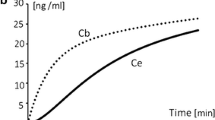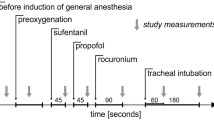Abstract
Haemodynamic, ECG T-wave amplitude and plasma potassium changes and plasma catecholamine responses to skin incision followed by alfentanil were studied in 24 ASA I patients. Propofol and vecuronium were used without anticholinergics for induction of anaesthesia followed by isoflurane in O2/air. End-tidal isoflurane concentration was kept constant (0.7%) for 30 min before the skin incision. Five min after the skin incision alfentanil 30 μg kg−1 was given. Blood samples for catecholamines and plasma potassium concentrations were drawn from right ventricle of the heart one minute before and after the skin incision and two minutes after alfentanil.
Heart rate, systolic and diastolic arterial pressures increased after the skin incision (P<0.001), and decreased after alfentanil (P<0.001). Plasma adrenaline and noradrenaline concentrations increased slightly after the skin incision (P<0.05 andP<0.01, respectively). Noradrenaline levels continued to increase after alfentanil (P<0.001) despite totally abolished haemodynamic responses to the skin incision.
ECG T-wave amplitude changes, measured as R/T ratio, did not correlate to the changes in plasma catecholamine levels: both rapid increases and decreases in R/T ratio were seen. No plasma potassium changes were seen during the trial. T-wave changes, occurring in seconds after the skin incision, are probably produced by a direct catecholamine release from cardiac sympathetic nerve endings.
Similar content being viewed by others

References
Furedy JJ, Heslegrave RJ. A consideration of recent criticisms of the T-wave amplitude index of myocardial sympathetic acticity. Psychophysiology 1983; 20: 204–211.
Contrada RJ, Krantz DS, Durel LA, Levy L, LaRiccia PJ, Anderson JR, Weiss T. Effects of beta-adrenergic activity on T-wave amplitude. Psychophysiology 1989; 26: 488–492.
Rau, H. Responses of the T-wave amplitude as a function of active and passive tasks and beta-adrenercig blockade. Psychophysiology 1991; 28: 231–239.
Hansen O, Johansson BW, Nilsson-Ehle P. Metabolic, electrocardiographic and hemodynamic responses to increased circulating adrenaline: effects of selective and nonselective beta adrenoreseptor blockade. Angiology 1990; 41: 175–188.
Struthers AD, Reid JL, Whitesmith R, Rodger JC. Effect of intravenous adrenaline on electrocardiogram, blood pressure and serum potassium. Br Heart J. 1983; 49: 90–93.
Annila P, Jäntti V, Lindgren L, Yli-Hankala A. Changes in the T-wave amplitude of ECG during isoflurane anaesthesia. Acta Anaesthesiol Scand 1993; 37: 611–615.
Gretler DD, Elliott WJ, Moscucci M, Childers RW, Murphy MB. Electrocardiographic changes during acute treatment of hypertensive emergencies with sodium nitroprusside or fenoldopam. Arch Intern Med 1992; 152: 2445–2448.
Graybar G, Goethe J, Levy T, Phillips J, Youngberg J, Smith D. Transient large upright T-wave on the electrocardiogram during multiple monitored electroconvulsive therapy. Anesthesiology 1983; 59: 467–469.
Khoury GF, Benedetti C. T-wave changes associated with electroconvulsive therapy. Anesth Analg 1989; 69: 677–679.
Rogers MC, Abildskov JA, Preston JB. Neurogenic ECG changes in critically ill patients: an experimental model. Crit Care Med 1973; 1: 192–196.
Scheinin M, Karhuvaara S, Ojala-Karlsson P, Kallio A, Koulu M. Plasma 3,4-dihydroxyphenylglycol (DHPG) and 3-methoxy-4-hydroxyphenylglycol (MHPG) are insensitive indicators of alpha2-adrenoreceptor mediated regulation of norepinephrine release in healthy human volunteers. Life Sci 1991; 49: 75–84.
Nygård M-E. Computer based detection of cardiac arrhythmias [dissertation]. Lindköping Studies in Science and Technology, 1983.
Loula P. Analysis of ECG and heart rate signals during anaesthesia and autonomic function tests [licentiate thesis]. Tampere Univ of Technology, 1991.
Oppenheimer SM, Cechetto DF. Cerebral electrocardiographic influences and their role in sudden death. Arch Neurol 1990; 47: 513–519.
Burch GE. The EKG, the heart and the CNS and autonomic nervoussystem. In: Schwartz PJ, Brown AM, Malliani A (eds.) Neural Mechanisms in Cardiac arrhythmias. Raven Press, New York 1978: 43–53.
Abildskov JA, Millar K, Burgess MJ, Vincent W. The electrocardiogram and the central nervous system. Prog Cardiovasc Dis 1970; 13: 210–216.
Lepeschkin E, Marchet H, Schroeder G, Wagner R, de Paula e Silva P, Raab W. Effect of epinephrine and norepinephrine on the electrocardiogram of 100 normal subjects. Am J Cardiol 1960; 5: 594–603.
Contrada RJ, Dimsdale J, Levy L, Weiss T. Effects of isoproterenol on T-wave amplitude and heart rate: a dose response study. Psychophysiology 1991; 28: 458–462.
Rosén KG, Dagbjartsson A, Henriksson BA, Lagercrantz H, Kjellmer I. The relationship between circulating catecholamines and ST waveform in the fetal lamb electrocardiogram during hypoxia. Am J Obstet Gynecol 1984; 149: 190–195.
Rosén KG. Alterations in the fetal electrocardiogram as a sign of fetal asphyxia-experimental data with a clinical implementation. J Perinat Med 1986; 14: 355–363.
Watanabe T, Okamura K, Tanigawara S, Shintaku Y, Akagi K, Endo H, Yajima A. Change in electrocardiogram T-wave amplitude during umbilical cord compression is predictive of fetal condition in sheep. Am J Obstet Gynecol 1992; 166: 246–255.
Meredith IT, Broughton A, Jennings GL, Esler MD. Evidence of a selective increase in cardiac sympathetic activity in patients with sustained ventricular arrhythmias. N Engl J Med 1991; 325: 618–624.
Velasquez MT, Alexander N. Plasma and lymph dopamine-β-hydroxylase and norepinephrine during carotid occlusion. Am J Physiol 1979; 236 H96-H100.
Kopin IJ. Plasma levels of catecholamines and dopamine-β-hydroxylase. In: Trendelenburg U, Weiner N, (eds.) Catecholamines II. Springer-Verlag, Berlin 1989; 211–275.
Monk TG, Mueller M, White PF. Treatment of stress response during balanced anesthesia. Comparative effects of isoflurane, alfentanil, and trimetaphan. Anesthesiology 1992; 76: 39–45.
Monk TG, Ding Y, White PF. Total intravenous anesthesia: effects of opioid versus hypnotic supplementation on autonomic responses and recovery. Anest Analg 1992; 75: 798–804.
Laubie M, Schmitt H, Canellas J, Roquebert J, Demichel P. Centrally mediated bradycardia and hypotension induced by narcotic analgesics: dextromoramide and fentanyl. Eur J Pharmacol 1974; 28: 66–75.
Flacke WE, Vercellino CE, Flacke JW, McIntee DE, Van Etten AP. Alfentanil and midazolam: direct vs. indirect circulatory effects. Anesthesiology 1987; 67: A47.
Phillips RA, Goldman ME, Ardeljan M, Eison HB, Shimabukuro S, Krakoff LR. Isolated T-wave abnormalities and evaluation of left ventricular wall motion after nifedipine for severe hypertension. Am J Hypertens 1991; 4: 432–437.
Pepi M, Alimento M, Maltagliati A, Guazzi MD. Cardiac hypertrophy in hypertension: Repolarisation abnormalities elicited by rapid lowering of pressure. Hypertension 1988 11: 84–91.
Ginn R, Vane JR. Dissappearance of catecholamines from the circulation. Nature 1968; 219: 740–742.
Fishman AP, Pietra CG: Handling of bioactive materials by the lung (second of two parts). N Engl J Med 1974;291:953–959.
Derbyshire DR, Chmielewski A, Fell D, Vater M, Achola K, Smith G. Plasma catecholamine responses to tracheal intubation. Br J Anaesth 1983; 55: 855–860.
Scheinin M, Koulu M, Laurikainen E, Allonen H. Hypokalaemia and other non-bronchial effects of inhaled fenoterol and salbutamol: a placebo-controlled dose-response study in healthy volunteers. Br J Clin Pharmacol 1987; 24: 645–653.
Author information
Authors and Affiliations
Rights and permissions
About this article
Cite this article
Annila, P.A., Lindgren, L., Loula, P. et al. The effect of skin incision followed by alfentanil on catecholamine levels and on the T-wave amplitude of ECG during isoflurance anaesthesia. J Clin Monitor Comput 12, 205–211 (1995). https://doi.org/10.1007/BF01207200
Accepted:
Issue Date:
DOI: https://doi.org/10.1007/BF01207200



